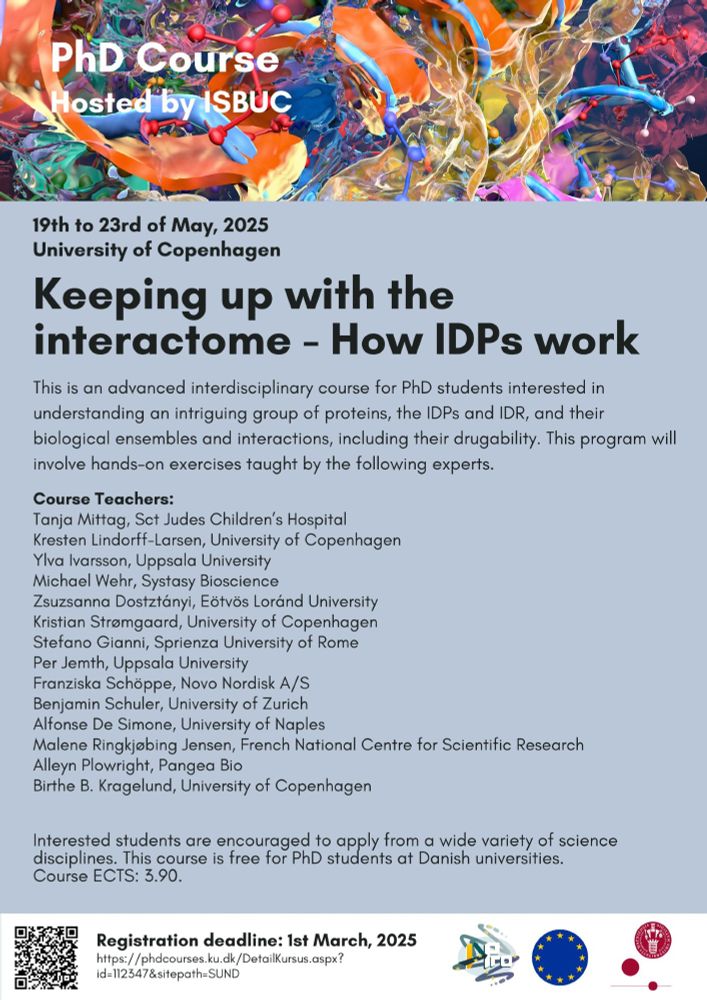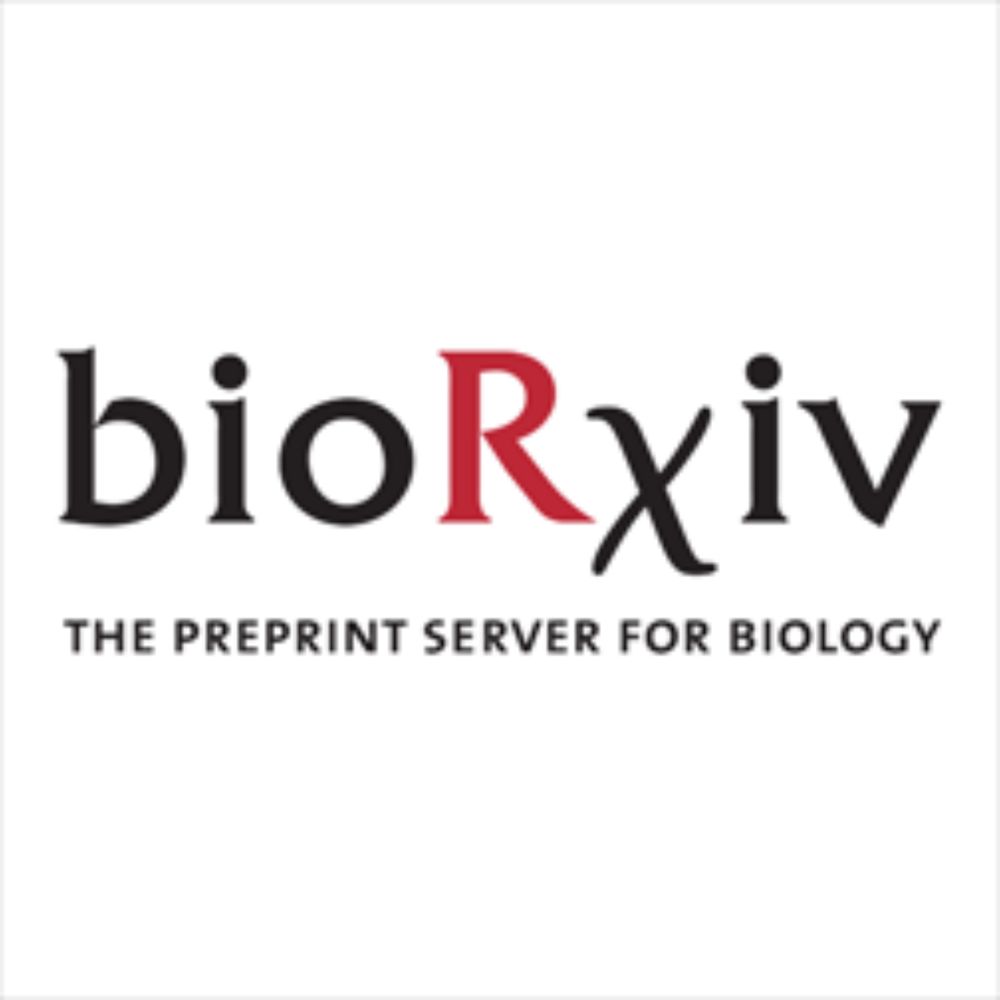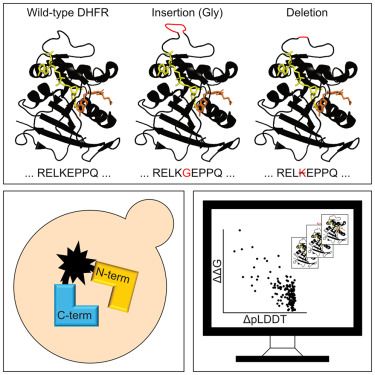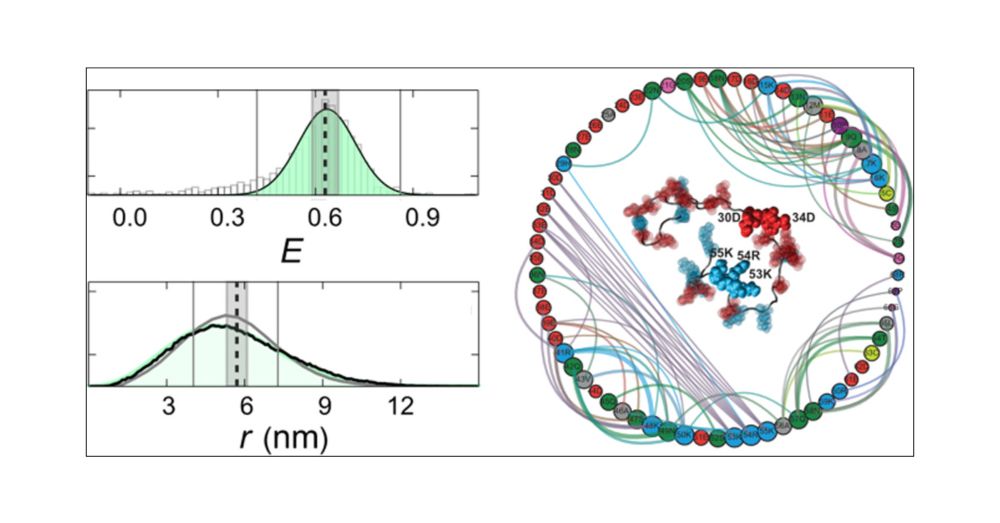We (@sobuelow.bsky.social) developed AF-CALVADOS to integrate AlphaFold and CALVADOS to simulate flexible multidomain proteins at scale
See preprint for:
— Ensembles of >12000 full-length human proteins
— Analysis of IDRs in >1500 TFs
📜 doi.org/10.1101/2025...
💾 github.com/KULL-Centre/...
20.10.2025 11:26 — 👍 89 🔁 37 💬 0 📌 0
Excited to see our review now on arXiv, written together with @fpesce.bsky.social and @lindorfflarsen.bsky.social
doi.org/10.48550/arX...
18.09.2025 21:44 — 👍 17 🔁 4 💬 0 📌 0
New preprint is out !
Bad news : current all-atom simulations of phosphorylated IDPs are very probably wrong (and yes, this is clickbaity on purpose 😇)
Good news : we know what to blame for it, and we even have an idea of how to fix it !
03.09.2025 06:54 — 👍 8 🔁 3 💬 1 📌 0
Our paper on:
A coarse-grained model for simulations of phosphorylated disordered proteins
(aka parameters for phospho-serine and -threonine for CALVADOS)
is now published in Biophysical Journal
authors.elsevier.com/a/1lTcE1SPTB...
@asrauh.bsky.social @giuliotesei.bsky.social & Gustav Hedemark
22.07.2025 05:58 — 👍 41 🔁 13 💬 1 📌 1
Arriën & Giulio's paper on
A coarse-grained model for disordered proteins under crowded conditions
(that is the CALVADOS PEG model) is now published in final form:
dx.doi.org/10.1002/pro....
@asrauh.bsky.social @giuliotesei.bsky.social
17.07.2025 08:54 — 👍 13 🔁 5 💬 0 📌 0
AlphaFold is amazing but gives you static structures 🧊
In a fantastic teamwork, @mcagiada.bsky.social and @emilthomasen.bsky.social developed AF2χ to generate conformational ensembles representing side-chain dynamics using AF2 💃
Code: github.com/KULL-Centre/...
Colab: github.com/matteo-cagia...
17.04.2025 19:10 — 👍 205 🔁 63 💬 3 📌 4
Led by @sobuelow.bsky.social & @giuliotesei.bsky.social we put together a full overview of the CALVADOS software and applications.
Give it a read: doi.org/10.48550/arX...
Give it a try: github.com/KULL-Centre/...
15.04.2025 14:18 — 👍 6 🔁 0 💬 0 📌 0
Thanks to @lindorfflarsen.bsky.social and all authors for this wonderful project on predicting IDR phase separation from sequence!
Check out the published version (including added exp. data from @tanjamittag.bsky.social) and feel free to try out our webserver.
25.03.2025 18:23 — 👍 23 🔁 4 💬 0 📌 0
Very happy to share our next extension to the CALVADOS protein force field:
If you want to explore the changes in global dimensions of a disordered protein upon phosphorylation: give it a read and a try!
Big thank you to @giuliotesei.bsky.social, @lindorfflarsen.bsky.social and Gustav S. Hedemark
21.03.2025 19:39 — 👍 8 🔁 2 💬 0 📌 0

A coarse-grained model for disordered proteins under crowded conditions
Big thank you to Giulio Tesei and @lindorfflarsen.bsky.social for their guidance.
The preprint can be found here: www.biorxiv.org/content/10.1...
The code and data are available here: github.com/KULL-Centre/...
09.03.2025 18:25 — 👍 2 🔁 0 💬 0 📌 0
Excited to share our PEG model for disordered proteins in CALVADOS!
If you are interested in exploring the effects of a crowder on the global dimensions of an IDP or want to explore the phase separation behaviour of a more weakly PS-prone IDP, have a look at our preprint and give it a try.
09.03.2025 17:41 — 👍 15 🔁 4 💬 1 📌 0

Figure from manuscript showing epresentative snapshots from slab simulations with 100 chains A1 (dark blue) with w/v-percentages of 0%, 5% (100:127) and 10% (100:254) PEG8000 (orange chains, 181 monomers) illustrating how PEG both lowers the 𝐶sat with increasing concentrations and also increases the effective protein concentration in the condensate (𝐶con).
Preprint submitted 🇺🇦
01.03.2025 22:22 — 👍 19 🔁 1 💬 0 📌 0

Figure from the paper that illustrates the approach of probing the transition state for amyloid growth by experiments and simulations
How do proteins mis-fold?
Paper led by Jacob Aunstrup from Alex Büll’s lab with MD simulations by Abigail Barclay, and key contributions from several others. We combined measurements of Φ-values with MD simulations to study the transition state for amyloid fibril growth
doi.org/10.1038/s415...
16.01.2025 15:09 — 👍 91 🔁 22 💬 1 📌 2
Check out @rasmusnorrild.bsky.social's work with Alex Buell and Joe Rogers developing and using Condensate Partitioning by mRNA-Display to probe phase separation of ~100.000 sequences, and @sobuelow.bsky.social's simulations to support and analyse the experiments
www.biorxiv.org/content/10.1...
21.12.2024 16:32 — 👍 36 🔁 8 💬 1 📌 0
Meet the CALVADOS RNA model
Ikki Yasuda, Sören von Bülow & Giulio Tesei have parameterized a simple model for disordered RNA. Despite it's simplicity (no sequence, no base pairing) we find that it captures several phenomena that depend on the charge, stickiness and polymer properties of RNA 🧬🧶🧪
29.11.2024 08:25 — 👍 89 🔁 21 💬 4 📌 2

Flyer for the course Keeping up with the interactome - How IDPs work including a list of speakers:
Professor Tanja Mittag, St Jude Children’s Hospital, Memphis, US
Professor Kresten Lindorff-Larsen, BIO, SCIENCE, UCPH
Professor Ylva Ivarsson, Uppsala University, Sweden
Dr. Michael Wehr, Systasy Bioscience, Munich, Germany
Professor Zsuzsanna Dostztányi, Eötvös Loránd University, Hungary
Professor Kristian Strømgaard, HEALTH, UCPH
Professor Stefano Gianni, Sprienza University of Rome, Italy
Professor Per Jemth, Uppsala University, Sweden
Dr. Franziska Schöppe, Novo Nordisk A/S, Denmark
Professor Benjamin Schuler, University of Zurich, Switzerland
Professor Alfonse De Simone, University of Naples, Italy
Dr. Malene Ringkjøbing Jensen, CNRS, Grenoble, France
Alleyn Plowright, Chief Scientific Officer, Pangea Bio, London UK
Professor Birthe B. Kragelund, BIO, SCIENCE, UCPH
If you are a PhD student and like protein disorder (or want to learn more), Birthe Kragelund @bbkrage.bsky.social and Kristian Strømgaard are organizing a PhD course on How IDPs work 🧶🧬🧪 Note the cost if you are not at a Danish university.
Details: phdcourses.ku.dk/DetailKursus...
25.11.2024 16:13 — 👍 60 🔁 27 💬 1 📌 2
Solve difficult biological problems using ML/AI.
Cancer Risk Assessment - “Catch Cancer Early”.
Perturbation Biology - computational cell biology - design new combo therapies.
Protein design - function and structure.
Protein Folder, father of two, married to @mariacaffarel.bsky.social
at UPV-EHU and DIPC
https://sites.google.com/view/biokt
4th year PhD student at Univ. of Groningen, in the group of Clemens Mayer. @rug.nl
Finding the next generation of biocatalysts by in vivo selections.
protein engineering - biocatalysis - biochemistry 🧪🧫🧬🔍
Associate Professor for Molecular Evolution at the University of Groningen. My group makes biomolecules to order by letting millions of them compete until a winner is crowned :) Sometimes it even works!
PhD student @ Computational Systems Biology & Lab of Gene Technology. Investigating PTMs in viruses and bacteria with bioinformatics 💻🦠
👩🏼💻 Science Communication @embo.org | 🎓 Senior Associate @lucycavcoll.bsky.social @cam.ac.uk | 🦠 PhD in Molecular Virology |📍Heidelberg, Germany | Views my own
https://www.linkedin.com/in/astrid-gall-she-her-ab4787138/
Professor, Georgia Tech Chemistry and Biochemistry. Georgia Research Alliance Eminent Scholar. Senior Editor, Protein Science. American, British, Swedish, Kurdish. Pianist, photographer, foodie, dreamer, mom. She/they. #FirstGen #MENA All views my own
Assistant Professor of Physics at WashU working in areas of biophysics and soft matter.
Assistant Professor at UCLA
HHMI Hanna Gray Faculty Fellow
PhD: Stanford Biophysics; Postdoc: Broad Institute
Excited about RNA+proteins+IDPs, high-throughput experiments+computation
At KITP on the UC Santa Barbara campus, researchers in theoretical physics and allied fields collaborate on questions at the leading edges of science.
www.kitp.ucsb.edu
Structural biologist working on 🖥️ protein design, machine learning🤖, crystallography💎, and cryoEM🔬. Avid weirdness connoisseur 🎩
Recognizing and celebrating Black scientists in Biophysics | Founder: @StevensSostre.bsky.social | Logo: Taneisha Gillyard-Cheairs, PhD | Web: blackinbiophysics.org | #BIBPSWeek2021 YouTube link: https://tinyurl.com/yvw86b53
Science writer and author of books including Bright Earth, The Music Instinct, Beyond Weird, How Life Works.
MRC Career Development Award Fellow @ University of Cambridge. Protein Chemist. I love lysozyme, amyloid fibrils and bimolecular condensates.
Propel Postdoctoral Fellow at Stanford. Interested in chromatin structure, LLPS, condensate structures.
The Nogales Lab @ UC Berkeley. #CryoEM #Transcription #Microtubules #ChromatinModification Bluesky account managed by lab members.
Stanford BioE, Genetics & Sarafan ChEM-H. Chan-Zuckerberg Biohub Investigator. Our lab develops and applies microfluidic assays for high-throughput biophysics and biochemistry.
Assistant Professor of Chemical and Biochemical Engineering at Rutgers University-New Brunswick






